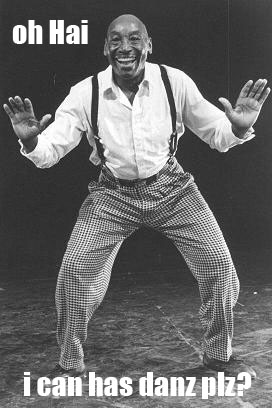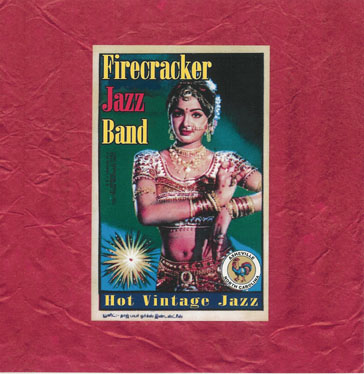 This lovely thing just arrived! Sure, it was a little embarrassing opening the door to the post dood wearing only a (very) short, light cotton dress, but I like to think I made his afternoon a little more interesting. But it was just GREAT to see a giant Mosaic cardboard box under his arm.
This lovely thing just arrived! Sure, it was a little embarrassing opening the door to the post dood wearing only a (very) short, light cotton dress, but I like to think I made his afternoon a little more interesting. But it was just GREAT to see a giant Mosaic cardboard box under his arm.
I love Lionel Hampton very much. He’s one of those guys I got into when I was first interested in DJing. In fact, I think his album Tempo and Swing was one of the first I bought thinking ‘this is DJing music’. I’m still a massive fan. He made great dancing music – stuff that’s really stompy and makes you want to get up and stomp around. Probably has something to do with his being a percussionist.
Anyhoo, it was interesting to see Ziggy Elman‘s name on the first page of the first CD’s liner notes. Elman’s interesting, not just because he’s responsible for the freakin’ awesome solo at the beginning of Tommy Dorsey’s song ‘Well git it!’. He caught my interest initially because he was a Jewish musician ‘performing’ whiteness – he changed his name.
This is something that Dean Collins also did (Saul Cohen originally). And all of this rings a bell with me because I keep coming across articles about Jewish musicians and actors who performed ‘blackness’ in the early days of radio and vaudeville – putting on ‘black’ accents and black face paint. It’s something I’d like to follow up in greater depth at some point, not only because of the interesting Jewish history of American show business, but also because of the ideological ramifications of ‘performing’ ethnicity in swing culture generally.
Because, of course, when we lindy hop, we are dancing what was an African American dance. Dancers who are into historical recreationism are particularly keen on emulating ‘black’ ways of moving and movement aesthetics. Which is problematic, when you remember that these are predominantly white, middle class kids (especially in America). But all this gets even more interesting when you take into account the fact that lindy hop is getting very popular in places like Korea. A recent exchange guest was telling me that there are thousands of swing dancers in Seoul, and that he social dances every single night of the week – far more often than we can here in Melbourne. And then, remember that not all Australian dancers are white – we see an increasingly multicultural local swing community here in Melbourne (though still not entirely multicultural or diverse).
But back to Ziggy Elman. His solo in ‘Well Git it!’ has particular cultural resonances for contemporary lindy hoppers, as mediated by the internet. The Mad Dog people performed a routine in Danvers to this song in 2002 which proved very popular with Australian dancers, particularly in the then-very-introverted Melbourne scene. Here was a group of young people dancing crazy, wild lindy hop without rules or costumes! Suddenly, there was an alternative to the carefully ‘safe’ teaching of the larger school, dancers who weren’t the ‘old’ recreationists (‘old’ being over 30, mind you). Suddenly, lindy hop got cool. Coolness which seemed to manifest in dancers wearing jeans in performances. And, most refreshingly for olden days music nerds like me, an increased general interest in music from the 1930s rather than 50s and 60s.
The Mad Dog troupe featured a bunch of young dancers who’re now rock stars, some of whom learnt to dance in Ithaca with Bill Borghida (and other teachers), and some of whom were in the Minnie’s Moochers dance troupe (circa 1999, 2000), which I remember being very influential. In fact, I remember watching this 2000 comp performance in my first year in Melbourne. This is as white a lindy hop performance as you’re going to see, but holy smokes, it’s tight. And these guys were young teenagers. If you’re familiar with Borghida’s teaching, you can see his sound technical foundations in there, and you can’t help but envy those kiddies their early start on lindy hop.
This performance is an interesting contrast with the Mad Dog routine in part because it is so tight and carefully choreographed – each dancer is attempting to dance and move in exactly the same way (here‘s an interesting clip of the girls doing solo charleston). In the Mad Dog routine we see choreographed steps, but each couple (and dancer) is quite unique. And of course, if you watch this composite clip of old school lindy hoppers, you can see that though the routines are really tight, each dancer has a unique style. The Big Apple contest is probably the best example of this. So this representation or performance of ‘individuality’ through improvisation and ‘styling’ signalled a shift away from very white, studio ballroom/concert dance aesthetics and towards a more ‘vernacular’ dance ethos. Vernacular in that people were actually dancing how they felt, in clothes they wore every day, with their own particular ‘accents’. And of course, lindy is just made for young people – it’s fast music, it’s crazy dancing, it’s irreverent, it’s badass*.
It’s probably worth pointing out that the American lindy hop competition culture in 2000 was very strictly regimented. The scoring was complicated, there was a whole range of weird rules about what you could and couldn’t do or wear in the competitions, and the type of dancing produced by these competitions was kind of… well, boring.
Competitions were kind of the same in Australia at the time, though there were no competitions run by lindy hoppers with specific ‘lindy hop’ categories. The biggest Australian competition at the time was ‘Best of the Best’, run by the VRRDA (Victorian Rock and Roll Dance Association), similarly constrained and rules-bound. It was also very much a ‘rock and roll’ competition – it was unusual to see ‘real’ lindy hop performances until about 2002.
In 2002 the MLX hosted the first Hellzapoppin’ competition, a model borrowed from the American Hellza competition – no rules, an impetus towards historical ‘authenticity’, run as part of an African American cultural history festival in Harlem. Though the American Hellza comp has been largely superseded by the ULHS (Ultimate Lindy Hop Show Down) competition for wild, crazy, ‘authentic’ lindy hop – not to mention popularity – Hellza is the only competition in Australia which actually carries on this particular ethos. All other large competitions in Australia are run by one school, and this school’s teachers tend to dominate the field, with the general tone being a little… straight.
So the 2002 Mad Dog performance is important as it signaled a diversion from the rules-bound competitions of previous years. The Mad Dog routine is probably more significant in American lindy as it was a very public diversion from the supergroove style that was popular at the time. I recently heard one of those dancers make a general comment about how ‘we’ used to dance ‘groovier, smoother’ and are not into ‘rawer’ dancing. It struck me as an example of how American dancers often generalise their experiences to the international community. But this is important stuff because these dancers were very young (and still are – under 30) and have been very influential in Australia.
So Ziggy Elman’s name probably carries a little more interpretive weight for me than for most people, and one day I’m going to read up on all that stuff on Jewish showbiz history. I promise.
For now I’m busy filling up the last tiny bits of space left on my hard drive with Lionel Hampton goodness. Yeah!
* old people like it too. Frankie is 93 and he still likes it.




